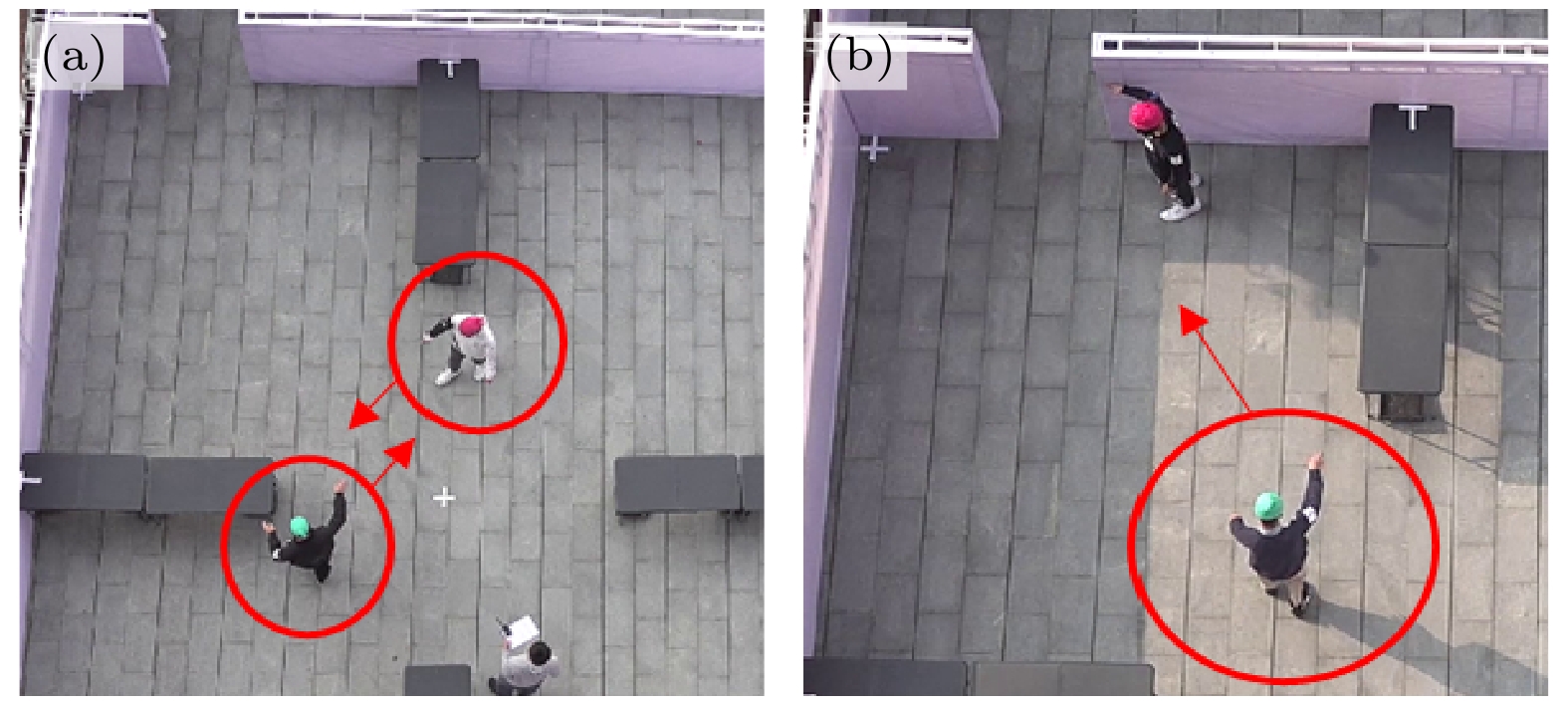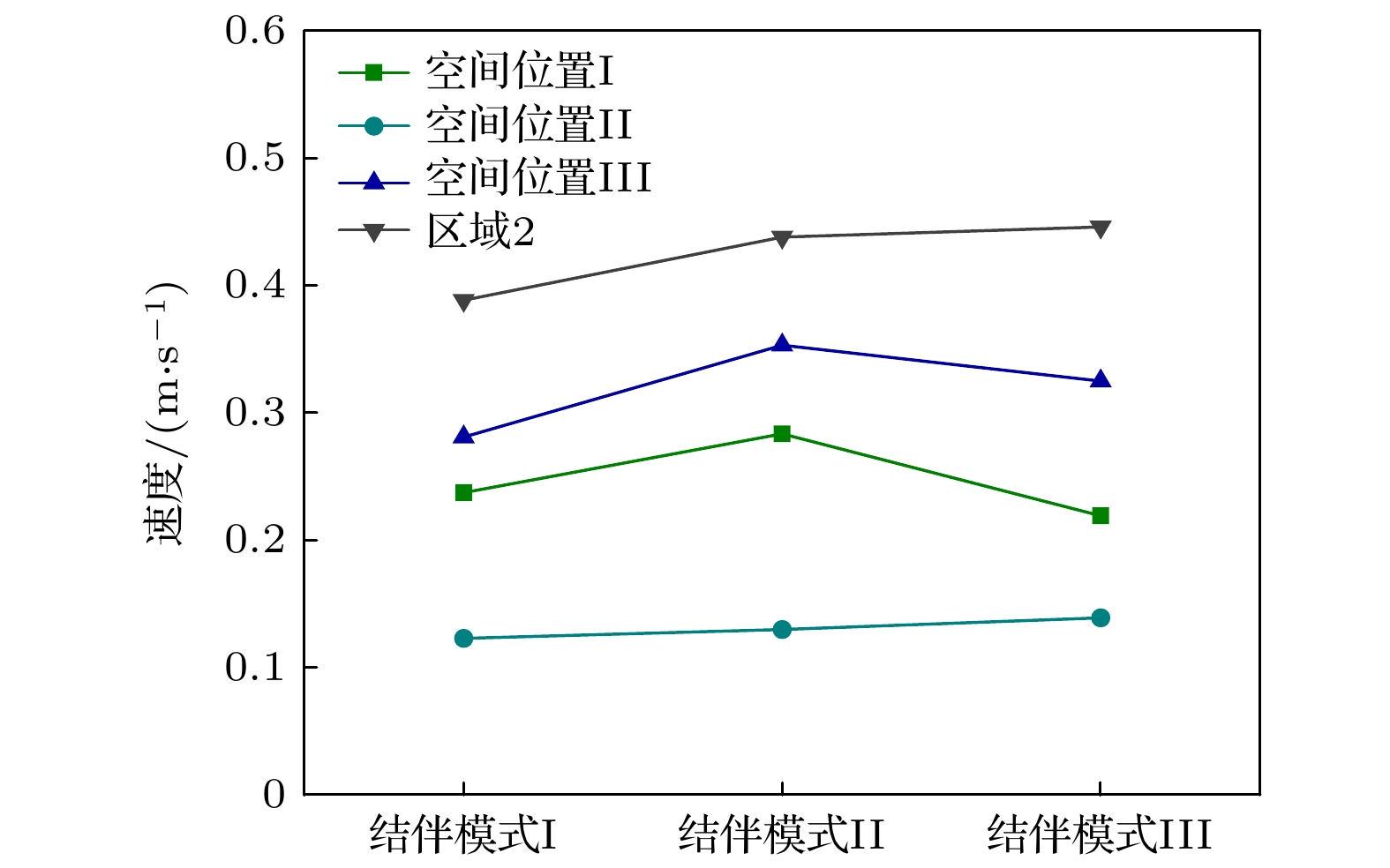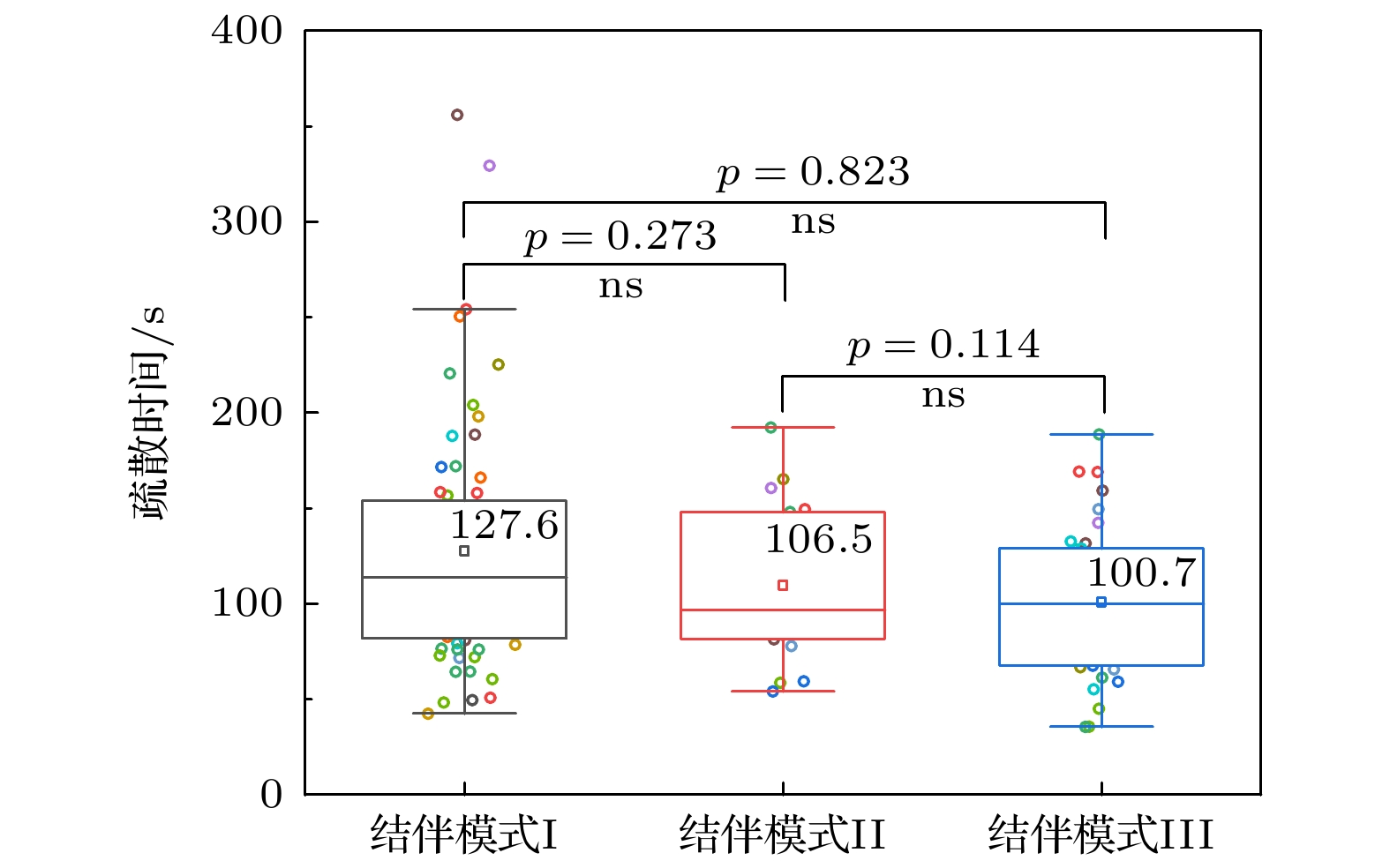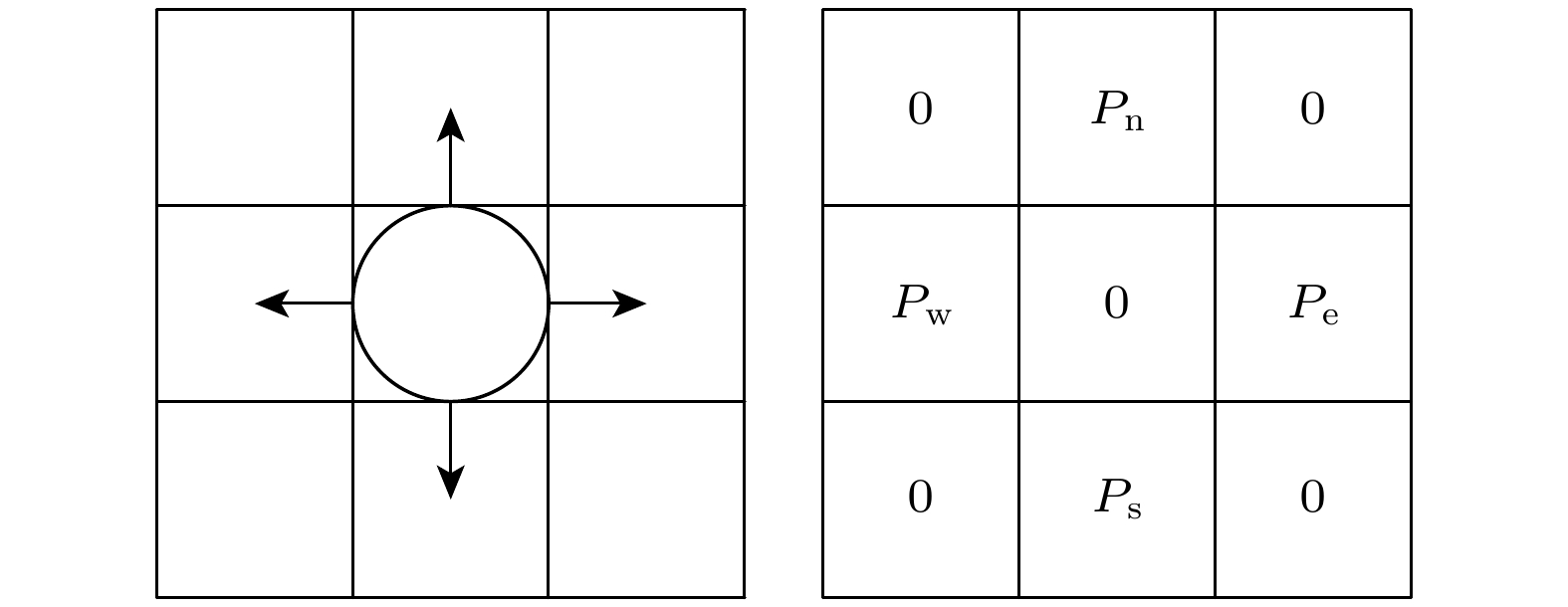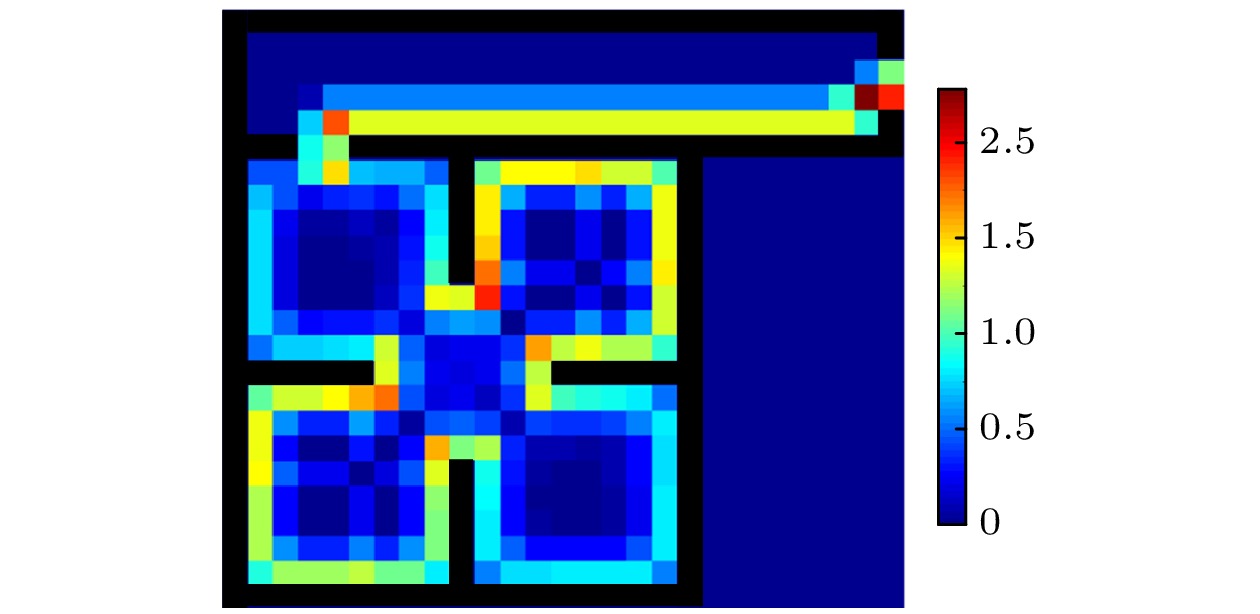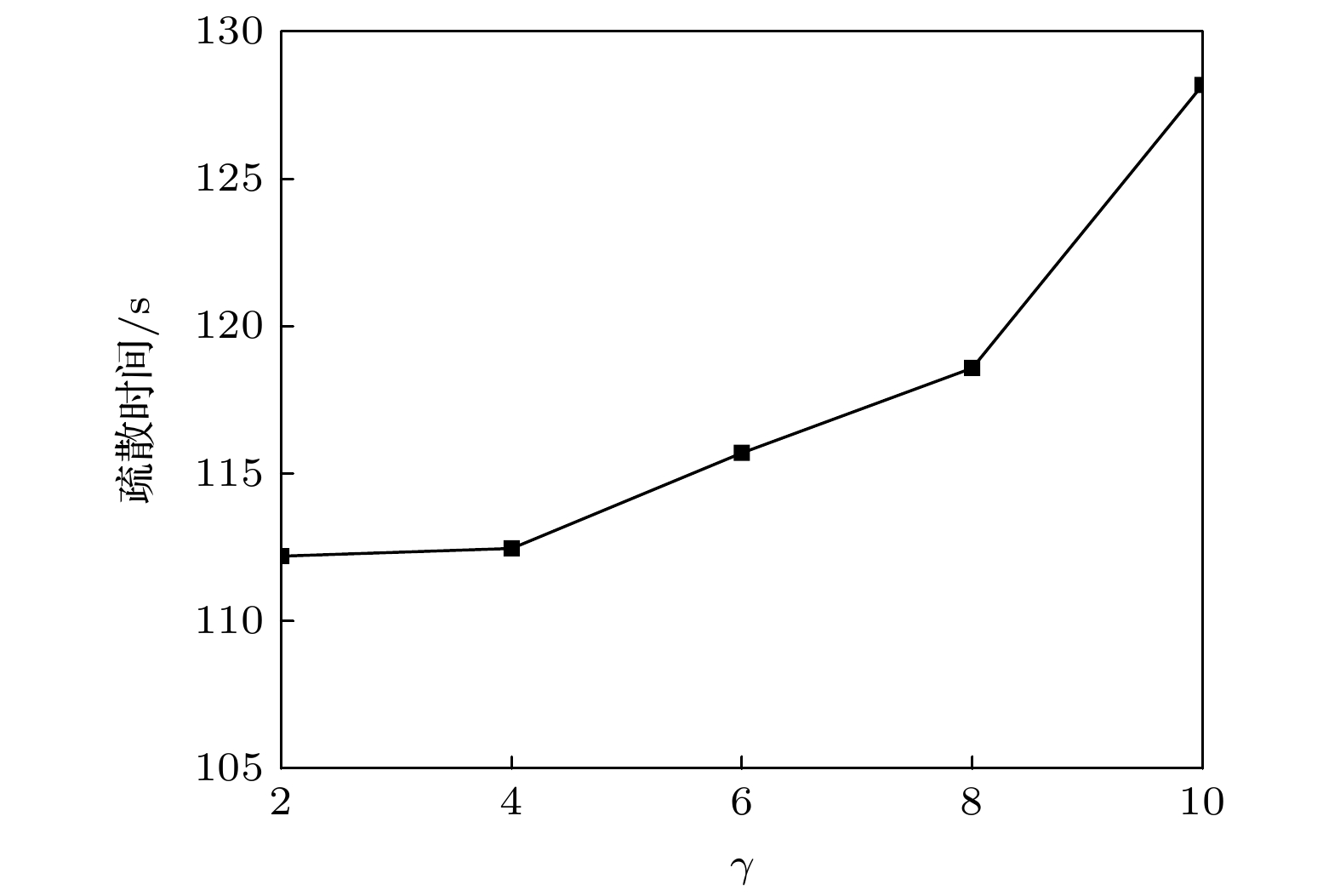-
为研究零视野条件下结伴行为对行人疏散过程的影响, 本文采用可控实验与建模仿真相结合的方法, 对零视野条件下结伴行人的疏散过程进行深入研究. 首先, 通过组织零视野条件下行人的结伴疏散实验, 发现了零视野条件下结伴行人的结伴行为、听觉引导行为和沿墙行为等典型疏散行为特征. 然后, 考虑不同结伴模式下行人的运动行为特征以及听觉引导行为、沿墙行为对结伴疏散过程的影响机制, 构建了基于元胞自动机的零视野条件下行人疏散模型. 最后, 利用实验结果对提出的模型进行验证, 仿真研究了零视野条件下结伴行为对疏散过程的影响. 结果表明, 模型能有效地刻画零视野条件下结伴行人的疏散行为特征, 疏散效率随结伴感知距离增加而降低. 该研究可为类似场景中行人疏散策略和方案的制定提供科学依据.The influences of group behavior on pedestrian evacuation under zero-visibility conditions are analyzed in depth by combining controlled experiments with modeling and simulation in this work. Initially, by experiments on pedestrian evacuation under zero-visibility conditions, typical evacuation behaviors are identified such as group behavior, auditory guidance behavior, and wall-following behavior. The pedestrians rely on auditory information to guide their companions in the process of forming groups. Pedestrian group behavior can be divided into three modes, the walking speeds of grouped pedestrians greatly depending on their spatial positions. By comparing and analyzing the walking speeds and evacuation times of pedestrians under different grouping modes, it is found that group behavior under zero-visibility condition reduces evacuation efficiency, while walking along the walls can improve evacuation efficiency. Subsequently, considering the movement characteristics of pedestrians in different group behavior modes, the influence mechanisms of auditory guidance and wall-following behavior on the evacuation process, a pedestrian evacuation model based on cellular automata under zero-visibility conditions is developed. Finally, the proposed model is validated by using experimental results, and simulations are conducted to analyze the influences of group behavior on the evacuation process under zero-visibility conditions. By comparing and analyzing the pedestrian movement trajectories and evacuation times during both the simulation and experiment, it is verified that the model can effectively reproduce the group evacuation processes of pedestrians under zero-visibility conditions. When auditory guidance errors are considered, pedestrians exhibit wandering behaviors in their movement trajectories. In the evacuation process, the greater the distance that pedestrians can perceive each other for grouping, the higher the probability of group formation is. As a result, groups are formed earlier, which will reduce the evacuation efficiency. This indicates that under zero-visibility conditions, group behavior exerts a negative influence on the evacuation process. This research lays a scientific foundation for formulating pedestrian evacuation strategies and schemes in similar scenarios.
-
Keywords:
- evacuation experiments /
- zero-visibility conditions /
- group behavior /
- cellular automaton model
[1] 任建强, 倪顺江 2024 清华大学学报(自然科学版) 64 471
 Google Scholar
Google Scholar
Ren J Q, Ni S J 2024 J. Tsinghua Univ. (Sci. Technol.) 64 471
 Google Scholar
Google Scholar
[2] Moussaïd M, Perozo N, Garnier S, Dirk H, Guy T 2010 PloS One 5 e10047
 Google Scholar
Google Scholar
[3] 岳昊, 邵春福, 关宏志, 段龙梅 2010 物理学报 59 4499
 Google Scholar
Google Scholar
Yue H, Shao C F, Guan H Z, Duan L M 2010 Acta Phys. Sin. 59 4499
 Google Scholar
Google Scholar
[4] 霍非舟, 范丹丹, 刘昶, 马亚萍, 吕紫含, 李梦令 2023 中国安全科学学报 33 126
 Google Scholar
Google Scholar
Huo F Z, Fan D D, Liu C, Ma Y P, Lv Z H, Li M L 2023 CSSJ 33 126
 Google Scholar
Google Scholar
[5] Fu L B, Cao S C, Shi Y Q, Chen S, Yang P, Fang J 2019 Saf. Sci. 117 447
 Google Scholar
Google Scholar
[6] 张蕊, 杨静, 杨晨威, 代盛旭 2019 交通运输系统工程与信息 19 163
 Google Scholar
Google Scholar
Zhang R, Yang J, Yang C W, Dai S X 2019 TSEIT 19 163
 Google Scholar
Google Scholar
[7] 武鑫森, 岳昊, 刘秋梅, 张旭, 邵春福 2021 物理学报 70 148901
 Google Scholar
Google Scholar
Wu X S, Yue H, Liu Q M, Zhang X, Shao C F 2021 Acta Phys. Sin. 70 148901
 Google Scholar
Google Scholar
[8] 周金旺, 邝华, 刘慕仁, 孔令江 2009 物理学报 58 3001
 Google Scholar
Google Scholar
Zhou J W, Kuang H, Liu M R, Kong L J 2009 Acta Phys. Sin. 58 3001
 Google Scholar
Google Scholar
[9] Wei X G, Lv W, Song W G, Li X 2015 Complexity 20 87
 Google Scholar
Google Scholar
[10] Gorrini A, Vizzari G, Bandini S 2016 Collective Dyn. 1 1
 Google Scholar
Google Scholar
[11] Chen L, Tang T Q, Song Z Q, Song Ziqi, Huang H J, Guo R Y 2019 Simul. Model. Pract. Theory 90 31
 Google Scholar
Google Scholar
[12] Cuesta A, Abreu O, Balboa A, Daniel A 2021 Fire Saf. J. 120 103018
 Google Scholar
Google Scholar
[13] Ren J X, Mao Z L, Zhang D, Gong M, Zuo S 2022 Int. J. Disaster Risk Reduct. 80 103228
 Google Scholar
Google Scholar
[14] Xie W, Zhang Y C, Cheng Y Y, Chen S M, Liang X W, Zhang W B 2018 Procedia Eng. 211 830
 Google Scholar
Google Scholar
[15] Xie W, Lee E W M, Li T, Shi M, Cao R F, Zhang Y C 2021 Saf. Sci. 133 105029
 Google Scholar
Google Scholar
[16] Was J, Porzycki J, Schmidt-Polończyk N 2020 Collective Dyn. 5 93
 Google Scholar
Google Scholar
[17] Xue S Q, Jiang R, Wong S C 2020 Transportmetrica A 16 626
 Google Scholar
Google Scholar
[18] Zeng G, Li Z, Ye R, Cao S 2024 Tunn. Undergr. Space Technol. 146 105661
 Google Scholar
Google Scholar
[19] 童蔚苹, 程琳 2014 系统工程理论与实践 34 2386
 Google Scholar
Google Scholar
Tong W P, Cheng L 2014 Systems Eng. Theory Practice 34 2386
 Google Scholar
Google Scholar
[20] Guo C L, Huo F Z, Li C, Li Y 2023 Physica A 615 128602
 Google Scholar
Google Scholar
[21] Zhou Y, Zhou Z P, Pu Z Y, Qi Y, Xu Y N 2019 Transp. Res. Rec. 2673 851
 Google Scholar
Google Scholar
[22] National Library of Standards of China National Institute of Standardization https://www.nssi.org.cn/nssi/front/124378676.html [2024-7-11]
[23] Lei W J, Li A G, Gao R, Hao X P, Deng B S 2012 Physica A 391 5355
 Google Scholar
Google Scholar
[24] 武悦, 康健 2016 城市建筑 16 121
 Google Scholar
Google Scholar
Wu Y, Kang J 2016 UA 16 121
 Google Scholar
Google Scholar
-
-
[1] 任建强, 倪顺江 2024 清华大学学报(自然科学版) 64 471
 Google Scholar
Google Scholar
Ren J Q, Ni S J 2024 J. Tsinghua Univ. (Sci. Technol.) 64 471
 Google Scholar
Google Scholar
[2] Moussaïd M, Perozo N, Garnier S, Dirk H, Guy T 2010 PloS One 5 e10047
 Google Scholar
Google Scholar
[3] 岳昊, 邵春福, 关宏志, 段龙梅 2010 物理学报 59 4499
 Google Scholar
Google Scholar
Yue H, Shao C F, Guan H Z, Duan L M 2010 Acta Phys. Sin. 59 4499
 Google Scholar
Google Scholar
[4] 霍非舟, 范丹丹, 刘昶, 马亚萍, 吕紫含, 李梦令 2023 中国安全科学学报 33 126
 Google Scholar
Google Scholar
Huo F Z, Fan D D, Liu C, Ma Y P, Lv Z H, Li M L 2023 CSSJ 33 126
 Google Scholar
Google Scholar
[5] Fu L B, Cao S C, Shi Y Q, Chen S, Yang P, Fang J 2019 Saf. Sci. 117 447
 Google Scholar
Google Scholar
[6] 张蕊, 杨静, 杨晨威, 代盛旭 2019 交通运输系统工程与信息 19 163
 Google Scholar
Google Scholar
Zhang R, Yang J, Yang C W, Dai S X 2019 TSEIT 19 163
 Google Scholar
Google Scholar
[7] 武鑫森, 岳昊, 刘秋梅, 张旭, 邵春福 2021 物理学报 70 148901
 Google Scholar
Google Scholar
Wu X S, Yue H, Liu Q M, Zhang X, Shao C F 2021 Acta Phys. Sin. 70 148901
 Google Scholar
Google Scholar
[8] 周金旺, 邝华, 刘慕仁, 孔令江 2009 物理学报 58 3001
 Google Scholar
Google Scholar
Zhou J W, Kuang H, Liu M R, Kong L J 2009 Acta Phys. Sin. 58 3001
 Google Scholar
Google Scholar
[9] Wei X G, Lv W, Song W G, Li X 2015 Complexity 20 87
 Google Scholar
Google Scholar
[10] Gorrini A, Vizzari G, Bandini S 2016 Collective Dyn. 1 1
 Google Scholar
Google Scholar
[11] Chen L, Tang T Q, Song Z Q, Song Ziqi, Huang H J, Guo R Y 2019 Simul. Model. Pract. Theory 90 31
 Google Scholar
Google Scholar
[12] Cuesta A, Abreu O, Balboa A, Daniel A 2021 Fire Saf. J. 120 103018
 Google Scholar
Google Scholar
[13] Ren J X, Mao Z L, Zhang D, Gong M, Zuo S 2022 Int. J. Disaster Risk Reduct. 80 103228
 Google Scholar
Google Scholar
[14] Xie W, Zhang Y C, Cheng Y Y, Chen S M, Liang X W, Zhang W B 2018 Procedia Eng. 211 830
 Google Scholar
Google Scholar
[15] Xie W, Lee E W M, Li T, Shi M, Cao R F, Zhang Y C 2021 Saf. Sci. 133 105029
 Google Scholar
Google Scholar
[16] Was J, Porzycki J, Schmidt-Polończyk N 2020 Collective Dyn. 5 93
 Google Scholar
Google Scholar
[17] Xue S Q, Jiang R, Wong S C 2020 Transportmetrica A 16 626
 Google Scholar
Google Scholar
[18] Zeng G, Li Z, Ye R, Cao S 2024 Tunn. Undergr. Space Technol. 146 105661
 Google Scholar
Google Scholar
[19] 童蔚苹, 程琳 2014 系统工程理论与实践 34 2386
 Google Scholar
Google Scholar
Tong W P, Cheng L 2014 Systems Eng. Theory Practice 34 2386
 Google Scholar
Google Scholar
[20] Guo C L, Huo F Z, Li C, Li Y 2023 Physica A 615 128602
 Google Scholar
Google Scholar
[21] Zhou Y, Zhou Z P, Pu Z Y, Qi Y, Xu Y N 2019 Transp. Res. Rec. 2673 851
 Google Scholar
Google Scholar
[22] National Library of Standards of China National Institute of Standardization https://www.nssi.org.cn/nssi/front/124378676.html [2024-7-11]
[23] Lei W J, Li A G, Gao R, Hao X P, Deng B S 2012 Physica A 391 5355
 Google Scholar
Google Scholar
[24] 武悦, 康健 2016 城市建筑 16 121
 Google Scholar
Google Scholar
Wu Y, Kang J 2016 UA 16 121
 Google Scholar
Google Scholar
计量
- 文章访问数: 3620
- PDF下载量: 105
- 被引次数: 0















 下载:
下载:




